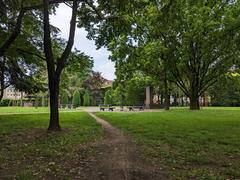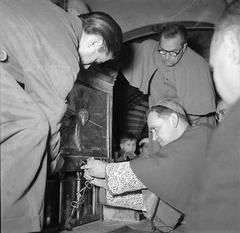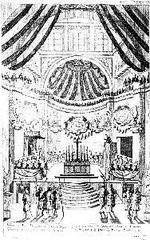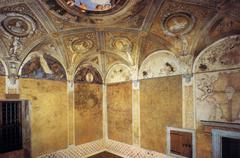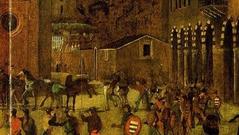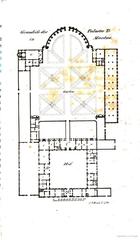
Palazzo Cavriani Visiting Hours, Tickets, and Guide to Mantua’s Historic Sites
Date: 04/07/2025
Introduction
Palazzo Cavriani stands as one of Mantua’s most remarkable historical sites, inviting visitors to immerse themselves in the aristocratic heritage, architectural splendor, and artistic richness that define this UNESCO-listed city. Located both in the heart of Mantua and in the nearby town of Volta Mantovana, the palace exemplifies centuries of evolving tastes—from Renaissance beginnings under the Gonzaga dynasty to neoclassical transformations by the Cavriani family. This guide delivers comprehensive, up-to-date information on Palazzo Cavriani’s visiting hours, ticketing, accessibility, and cultural significance, enabling travelers and history lovers to plan an enriching visit.
For updated visitor information and special events, consult the Garda Tourism portal, the FAI Fondo Ambiente Italiano, and the Mantua Tourism Portal.
Historical Background
Origins and Renaissance Development
The origins of Palazzo Cavriani, also referred to as Palazzo Gonzaga-Cavriani in Volta Mantovana, date to the mid-15th century when Ludovico Gonzaga, Marquis of Mantua, commissioned its construction as a country residence. The strategic location on the Mincio River, with remnants of medieval defensive structures, reflected both the leisure pursuits and the security needs of the Gonzaga family (GardaTourism). The palazzo’s design is distinct for its asymmetrical façade and prominent chimneys, diverging from the classical symmetry typical of urban Renaissance palaces.
Expansion under the Guerrieri and Cavriani Families
A significant expansion occurred in 1515 when Ludovico Guerrieri took ownership, transforming the property into a refined noble residence. The 18th and 19th centuries witnessed a neoclassical makeover under the Cavriani family, with the palace’s architecture and interior decoration evolving to reflect contemporary tastes (GardaTourism; Wikipedia).
Civic Role and Preservation
By the 20th century, the property transitioned to public hands and now serves as a site for municipal functions, cultural events, and guided tours. This evolution from private residence to civic landmark underscores its integral role in Mantua’s social and cultural fabric (GardaTourism).
Architectural and Artistic Highlights
Exterior Features
Palazzo Cavriani’s neoclassical façade along Via Trento (Mantua) or its striking asymmetry in Volta Mantovana marks it as an architectural standout. The urban palace, designed by Alfonso Torreggiani and completed in 1756, features a harmonious window rhythm, ornate ironwork, and sculpted marble busts at the main entrance (English Wikipedia). In Volta Mantovana, the building integrates medieval towers and remnants of village walls, preserving its defensive past.
Interiors and Artistic Heritage
The palace interiors boast frescoes and stuccoes by artists such as Giuseppe Bazzani, Francesco Maria Raineri, and Teodoro Ghisi. Highlights include:
- The grand salone d’onore (main salon) with elaborate ceiling frescoes and stucco decoration.
- Vault frescoes in the old oratory’s apse, attributed to Teodoro Ghisi, reflecting a connection to Mantua’s celebrated artistic circles.
- Neoclassical ballrooms and wooden ceilings dating to the 16th century, exemplifying successive artistic influences (Elle Decor).
Gardens and Sculpture
The palace’s Italianate garden—especially notable in Mantua’s urban core—was laid out in the early 19th century, featuring geometric flowerbeds and mature trees. A central marble statue of Virgil by Stefano Gerola and a series of Renaissance luminary busts by Chiozzini and Silva punctuate the landscape (English Wikipedia). Painted trompe-l’oeil perspectives by Alessandro Ferraresi further enhance the garden’s ambiance.
Cultural Significance
Palazzo Cavriani is a living testament to Mantua’s aristocratic culture. While grand public sites like Palazzo Ducale and Palazzo Te highlight ducal power, Cavriani offers a glimpse into the private world of Mantua’s nobility, where literary salons, musical performances, and intellectual gatherings flourished. The Cavriani family’s patronage of the arts enriched Mantua’s reputation as a hub of enlightenment, and their palace remains a symbol of the city’s enduring cultural vitality (FAI Fondo Ambiente Italiano).
Visiting Palazzo Cavriani: Hours, Tickets, and Accessibility
Location
- Mantua: Palazzo Cavriani (urban) is located on Via Trento, near other major attractions such as Palazzo Ducale, Basilica Palatina Santa Barbara, and Palazzo d’Arco (Trek Zone).
- Volta Mantovana: The rural palazzo, also known as Palazzo Gonzaga-Cavriani, is situated in the historic town center, accessible via car or public transport from Mantua.
Opening Hours
- Mantua: The palazzo is generally open during special events, exhibitions, and guided tours. Hours vary; check the Mantua Tourism Portal or local tourist offices for current schedules.
- Volta Mantovana: Open Saturdays from 15:00 to 18:00, and Sundays from 9:00 to 12:00 and 15:00 to 18:00 (GardaTourism).
Tickets and Booking
- Mantua: Admission fees apply for public openings and special events, with discounts for students, seniors, and groups. Advance booking is strongly recommended for guided tours.
- Volta Mantovana: Entrance is typically free, but group and guided tours may require advance booking through the municipal office.
Accessibility
Both locations have made efforts to improve accessibility, though historic features may limit access to certain areas. Inquire in advance for details, particularly regarding wheelchair access.
Guided Tours and Events
Guided tours are available during public openings and special events, providing in-depth insights into the palace’s history and art. The palace regularly hosts cultural events, exhibitions, and educational programming (FAI Fondo Ambiente Italiano).
Visitor Experience and Tips
- Combine Visits: Palazzo Cavriani is ideally located for inclusion in a walking tour of Mantua’s historic center, alongside sites like Palazzo Ducale and Palazzo Te (see Mantua’s top attractions).
- Plan Ahead: Due to limited public access, confirm opening times and ticket availability in advance.
- Enjoy Local Cuisine: Mantua is renowned for dishes such as pumpkin tortelli and risotto alla pilota—perfect for rounding out your cultural itinerary.
- Photography: Generally permitted in gardens and exteriors; interior photography may be restricted to protect artworks.
- Accessibility: Main entrances and gardens are usually accessible, but upper floors or certain historic rooms may have limited access.
Frequently Asked Questions (FAQ)
Q: What are Palazzo Cavriani’s visiting hours?
A: Visiting hours vary between Mantua and Volta Mantovana locations. In Volta Mantovana, open Saturdays 15:00–18:00, Sundays 9:00–12:00 and 15:00–18:00. Mantua’s urban palazzo is open during special events or by guided tour; check official platforms for updates.
Q: How can I purchase tickets?
A: Tickets are available during special openings and events, for purchase on-site or through official tourism channels. Advance booking is recommended.
Q: Is Palazzo Cavriani wheelchair accessible?
A: Main public areas and gardens generally offer access, but historic constraints may limit mobility in some sections.
Q: Are guided tours available?
A: Yes, guided tours are available in both Italian and English, especially during public openings and cultural events.
Q: What other sites are nearby?
A: In Mantua: Palazzo Ducale, Basilica Palatina Santa Barbara, Palazzo d’Arco. In Volta Mantovana: historic town center, Mincio River, and other Gonzaga-era sites.
Visual and Interactive Resources
- Images: High-resolution photos of the neoclassical façade, frescoed salons, and Italianate gardens are available on official tourism websites. Use descriptive alt text for accessibility, e.g., “Palazzo Cavriani neoclassical façade with wrought-iron gate.”
- Maps: Interactive maps highlight Palazzo Cavriani’s location within Mantua and Volta Mantovana and indicate nearby attractions.
- Virtual Tours: Explore available 360-degree tours or video presentations through cultural organizations and tourism platforms (Mantua Tourism Portal).
Related Articles
- Palazzo Ducale: Mantua’s Grand Ducal Palace
- Discovering Palazzo Te: Renaissance Masterpiece
- Top 10 Mantua Historical Sites to Visit
Plan Your Visit
Before visiting, check the latest details on Garda Tourism, FAI Fondo Ambiente Italiano, and the Mantua Tourism Portal for current hours, ticketing, and event information. Download the Audiala app for audio guides, offline maps, and updates on guided tours and cultural events across Mantua.
Palazzo Cavriani is more than a historic residence—it is a vibrant window into the layered history, artistic achievement, and cultural vitality that define Mantua and its surroundings. Plan your visit today and experience one of Lombardy’s most captivating historical treasures.
Sources and Further Reading
- GardaTourism, 2025, Palazzo Gonzaga-Cavriani
- FAI Fondo Ambiente Italiano, 2025, Palazzo Gonzaga-Cavriani
- Wikipedia, 2025, Palazzo Cavriani, Mantua
- English Wikipedia, 2025, Palazzo Cavriani, Mantua
- Mantua Tourism Portal, 2025
- She Goes The Distance, 2025, Mantua Italy
- Culture Activities: Things to Do in Mantua, 2025
- Trek Zone, 2025, Palazzo Cavriani Mantua
- Elle Decor, 2025, Palazzo Beccaguti Cavriani Mantova
- Adventure Backpack, 2025, Mantua Highlights
- The Geographical Cure, 2025, Guide to the Treasures of Mantua




